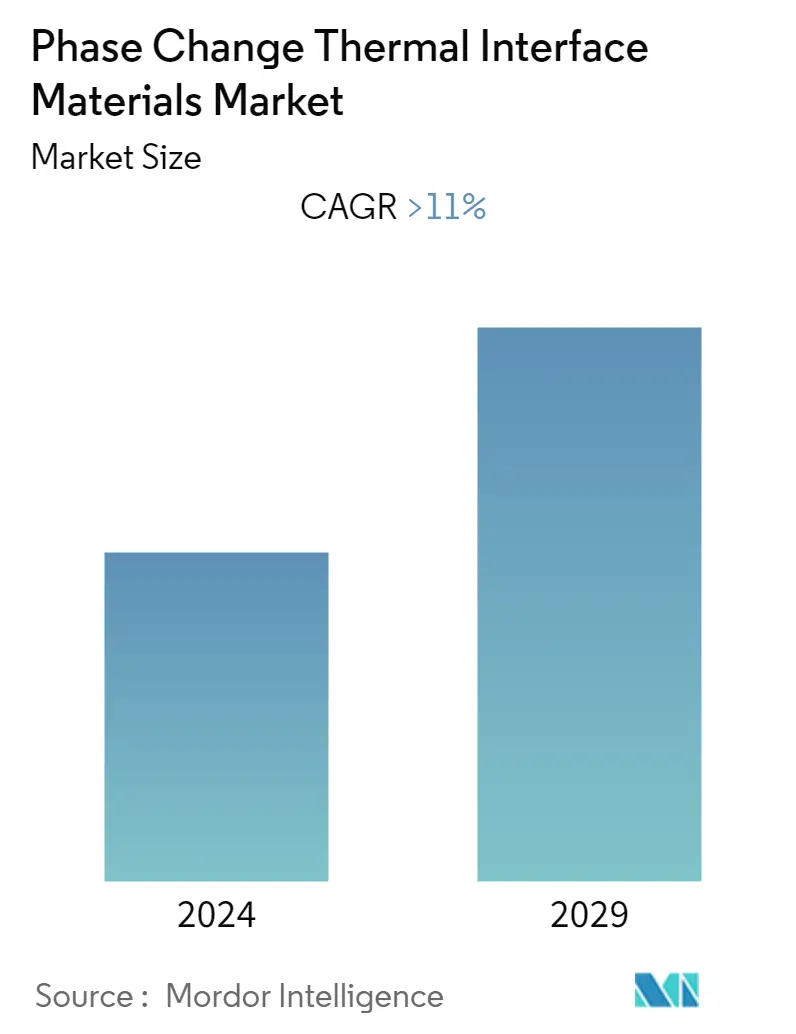Market Size of Phase Change Thermal Interface Materials Industry

| Study Period | 2019 - 2029 |
| Base Year For Estimation | 2023 |
| CAGR | > 11.00 % |
| Fastest Growing Market | North America |
| Largest Market | Asia Pacific |
| Market Concentration | Low |
Major Players*Disclaimer: Major Players sorted in no particular order |
Phase Change Thermal Interface Material Market Analysis
The phase change thermal interface materials market is expected to register a CAGR of more than11% during the forecast period. Major factors driving the market studied are the growing consumer electronics industry, high cost of surface finishing, augmented the functionality of electronic devices, and increasing demand from the gaming module industry. However, the reduction in the size of mobile handsets and the development of non-silicone substitutes are expected to hinder market growth.
- The computer application segment dominated the marketand is expected to grow during the forecast period, owing to the rapid internet penetration in the developing countries.
- Replacement of thermal greases is likely to act as an opportunity in the future.
- Asia-Pacific dominated the global market, with the largest consumption from the countries, such as China, and Japan.
Phase Change Thermal Interface Material Industry Segmentation
The scope of the phase change thermal interface materials market report includes:
| By Conductive Type | |
| Electrically Conductive | |
| Non-electrically Conductive |
| By Binder Type | |
| Paraffin | |
| Non-paraffin (organic) | |
| Eutectic salts | |
| Salt hydrates |
| By Filler Type | |
| Aluminum Oxide | |
| Boron Nitride | |
| Aluminum Nitride | |
| Zinc Oxide | |
| Other Filler Types |
| By End-user Industry | |
| Computers | |
| Electrical and Electronics | |
| Telecommunication | |
| Automotive | |
| Other End-user Industries |
| Geography | |||||||
| |||||||
| |||||||
| |||||||
|
Phase Change Thermal Interface Materials Market Size Summary
The phase change thermal interface materials (PCTIMs) market is poised for significant growth, driven by the expanding consumer electronics sector and the increasing demand from the gaming industry. These materials are essential for managing heat dissipation in semiconductor devices, offering long-term reliability and performance without incurring additional costs or space requirements. The market is experiencing robust demand in the Asia-Pacific region, particularly in China and Japan, due to rapid internet penetration and the growing popularity of larger displays like laptops and tablets. However, challenges such as the reduction in mobile handset sizes and the emergence of non-silicone substitutes may impede market expansion.
The computer application segment leads the market, benefiting from the surge in internet usage in developing countries. The replacement of thermal greases presents future opportunities for market growth. While the consumer electronics industry in North America and Europe has reached maturity, the Internet of Things (IoT) and smart home technologies are expected to drive demand for PCTIMs in these regions. The market is characterized by fragmentation, with key players including Croda International PLC, Parker Hannifin Corp., Laird, Aavid Thermalloy (Boyd Corporation), and Honeywell International Inc. The ongoing advancements in China and Japan's electronics sectors, along with the burgeoning markets in India and ASEAN countries, are instrumental in the market's expansion.
Phase Change Thermal Interface Materials Market Size - Table of Contents
-
1. MARKET DYNAMICS
-
1.1 Drivers
-
1.1.1 Growing Consumer Electronics Industry
-
1.1.2 High Cost of Surface Finishing
-
1.1.3 Augmented Functionality of Electronic Devices
-
1.1.4 Increasing Demand from the Gaming Module Industry
-
-
1.2 Restraints
-
1.2.1 Reduction in Size of Mobile Handsets
-
1.2.2 Reduced Demand in Japan
-
1.2.3 Development of Non-silicone Substitutes
-
-
1.3 Industry Value-Chain Analysis
-
1.4 Porter's Five Forces Analysis
-
1.4.1 Bargaining Power of Suppliers
-
1.4.2 Bargaining Power of Consumers
-
1.4.3 Threat of New Entrants
-
1.4.4 Threat of Substitute Products and Services
-
1.4.5 Degree of Competition
-
-
1.5 Raw Material Analysis
-
1.6 Patent Analysis
-
-
2. MARKET SEGMENTATION
-
2.1 By Conductive Type
-
2.1.1 Electrically Conductive
-
2.1.2 Non-electrically Conductive
-
-
2.2 By Binder Type
-
2.2.1 Paraffin
-
2.2.2 Non-paraffin (organic)
-
2.2.3 Eutectic salts
-
2.2.4 Salt hydrates
-
-
2.3 By Filler Type
-
2.3.1 Aluminum Oxide
-
2.3.2 Boron Nitride
-
2.3.3 Aluminum Nitride
-
2.3.4 Zinc Oxide
-
2.3.5 Other Filler Types
-
-
2.4 By End-user Industry
-
2.4.1 Computers
-
2.4.2 Electrical and Electronics
-
2.4.3 Telecommunication
-
2.4.4 Automotive
-
2.4.5 Other End-user Industries
-
-
2.5 Geography
-
2.5.1 Asia-Pacific
-
2.5.1.1 China
-
2.5.1.2 India
-
2.5.1.3 Japan
-
2.5.1.4 South Korea
-
2.5.1.5 Rest of Asia-Pacific
-
-
2.5.2 North America
-
2.5.2.1 United States
-
2.5.2.2 Canada
-
2.5.2.3 Mexico
-
-
2.5.3 Europe
-
2.5.3.1 Germany
-
2.5.3.2 United Kingdom
-
2.5.3.3 Italy
-
2.5.3.4 France
-
2.5.3.5 Rest of Europe
-
-
2.5.4 Rest of World
-
2.5.4.1 Brazil
-
2.5.4.2 Saudi Arabia
-
2.5.4.3 South Africa
-
2.5.4.4 Rest of the World
-
-
-
Phase Change Thermal Interface Materials Market Size FAQs
What is the current Phase Change Thermal Interface Materials Market size?
The Phase Change Thermal Interface Materials Market is projected to register a CAGR of greater than 11% during the forecast period (2024-2029)
Who are the key players in Phase Change Thermal Interface Materials Market?
Croda International PLC, Parker Hannifin Corp., Laird, Aavid Thermalloy (Boyd Corporation) and Honeywell International Inc. are the major companies operating in the Phase Change Thermal Interface Materials Market.

